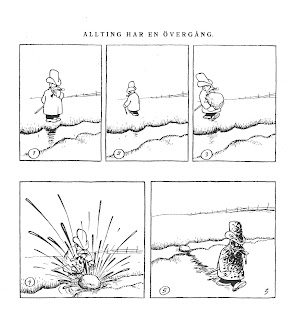Usually the comics of the 19th century offered a quite static viewpoint on scene: the viewer gets a scene from a certain distance, somewhat comparable to the position of a sitter in a theatre. The same distant, static viewpoint the early cinematographers would adopt as well.
But some comics artists used already a 'moving' viewpoint by using a variation of angles. For instance Töpffer used a kind parallel tracking for a running character. So the displacement of the viewpoint was motivated by the displacement of the character in regards to the background. The different background and the suggestion of a running character informs the viewer to understand that the character is in front of a somewhat different location.
But what if the location stays the same and the characters remain in their place? Also then, there were artists like Johann Bahr (1859-1930) who used a moving viewpoint. My sample comes from a Flemish magazine, De Nieuwe Belgische Illustratie (1891), but originally it was published most likely in a German illustrated magazine.

The comic starts outdoors, we see people looking at a poster, promoting a sensational act “The living speaking human head”. The second panel shows a different location and other characters from the first one. We are at the back of a tent, which seemingly open at the other end. At the forefront of the scene a man with a black heat tries to shoo some kids, in the back of the scene another adult, on a platform, is speaking to a small crowd. In the third panel, the viewpoint has changed a little bit, so that we no longer see what’s in front of the tent, but the attention is directed on the kids, that clearly have returned to the back of the tent, and they are trying to peep into the tent.
The whole next tier is located inside the tent, we have moved from the exterior to the interior.

The first panel of the second tier shows us at the left the boys peeping through, at the right the public, and in the middle the spectacle: the man who was speaking to the public from the second panel is now standing upright on a platform and is still directed towards the public. Next to him we see a small table, covered with a sheet, on top a human head. The viewer can see what’s hidden from the astonished public: below the small table, there a larger platform, from which, at the back, two naked feet are peeping through. In contrast to the public in front of the spectacle, only the kids, at the back, can see the feet. They are tickling his feet with a twig.
In the fifth panel we still are looking at the act, but from a different viewpoint, namely that of the public. It’s in fact a jump over the 180° degree line, but due to the clear context the viewer is not deranged: the situation remains comprehensible.
No need to repeat the tickling of the feet, we know already what’s going on behind the act. The text explains that the head is making grimaces, most likely the consequence of the tickling. In the sixth panel, the viewpoint is still from the public side, but a little more frontal towards the spectacle.
The last tier offers the twist and the conclusion.

The viewpoint has shifted a little bit to the right, somewhere between the angle of panel 5 and 6. The man, who was kneeling, can’t hold it any longer and jumps up. The secret of the act is thus revealed publicly. Due to a detail (the path) of his trousers, we recognize the figure from the second panel. The viewpoint of this panel is not easy to locate, because the tent is broken down by the furious public.
The very last panel shows a new location: the two cheats of the act are walking away from the city, on their wheelbarrow the remains of the tent. To make it worse for them, it’s raining. They do not seem happy.
So, though the panels keep the same dimensions and format, there’s a lot of shifting angles in this short gag of 9 panels. There are various changing angles and three different locations: one in the beginning and one at the end. The bulk of the panels present the space of the spectacle, presenting first the exterior before moving to the interior. Inside the tent Bahr cleverly shifts his angles to make the situation visibly clear to the viewer. He does not need the text to explain that the boys are secretly tickling the feet or how the fraud is being committed. He can do it by solely showing!
Pascal Lefèvre

















